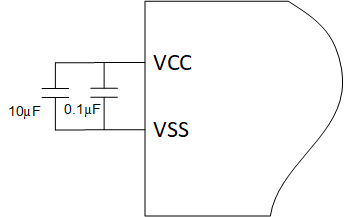SLAAE76B march 2023 – june 2023 MSPM0G1105 , MSPM0G1106 , MSPM0G1107 , MSPM0G1505 , MSPM0G1506 , MSPM0G1507 , MSPM0G3105 , MSPM0G3106 , MSPM0G3107 , MSPM0G3505 , MSPM0G3506 , MSPM0G3507
2.4 Recommended Decoupling Circuit for Power Supply
TI recommends connecting a combination of a 10-μF plus a 100-nF low-ESR ceramic decoupling capacitor to the DVCC pin (see Figure 2-3). Higher-value capacitors can be used but can impact supply rail ramp-up time. Decoupling capacitors must be placed as close as possible to the pins that they decouple (within a few millimeters).
 Figure 2-3 Power Supply Decoupling Circuit
Figure 2-3 Power Supply Decoupling Circuit